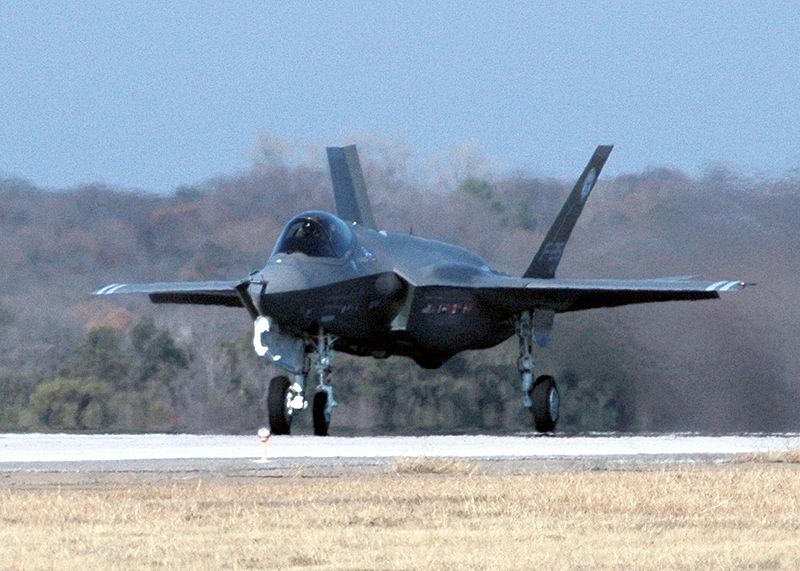December 15, 2006 - Lockheed Martin F-35 Lightning II fighter aircraft makes the first flight
The F-35 Lightning II was developed from an X-35 aircraft under the Joint Strike Fighter (JSF) project, a single-seat, capable, invisibility, multi-role fighter. perform tasks such as air support, tactical bombing, and air combat.
Its development has been included in the financial plans of the United States, United Kingdom and other coalition governments. It was designed and built by an aerospace industry complex led by Lockheed Martin and other members are BAE Systems and Northrop Grumman. The aircraft was manipulated in 2000; a prototype production model took off for the first time on December 15, 2006.

Design characteristics
The F-35 looks like a younger sibling, an engine and looks more normal than the smooth elder two F-22 Raptor engines, and, of course, borrowed some of its design elements. Engine exhaust design was influenced by General Dynamics' 200 test aircraft, a VTOL model designed for the Sea Control Ship program in 1972.
Stealth technology makes the aircraft difficult to detect by short-range radar.
Some improvements over the current generation of fighters are:
- Stealthy stealth techniques and less expensive maintenance;
- Radar and integrated sensors combine information on aircraft and from the ground to enhance the pilot's ability to recognize situations, identify opponents and use weapons, as well as relay information quickly. to other command and control buttons;
- High-speed data networks include IEEE-1394b and Fiber Channel.
- The cost of maintaining a low life cycle.
Although the technique of displaying information on a helmet-mounted display has been applied on some IV generation fighters such as Sweden's JAS 39 Gripen, the F-35 will be the first aircraft to be technically This will completely replace the front-up display technology.

Electronic systems
The main sensor of the F-35 is the AN / APG-81 active phase contrast radar, designed by Northrop Grumman Electronic Systems. It is complemented by the EOTS (Electro-Optical Targeting System) system mounted under the nose of the aircraft, designed by Lockheed Martin and BAE. Other optical-electronic sensors distributed on the fuselage are part of the AN / AAS-37 system that operates as missile warning systems, navigation and night flying.
Thrust / mass ratio
The F-35B modifier has the potential to reduce mobility features because straight-forward equipment makes it much heavier - up to 1 ton (2,200 lbs) or 8%. To compensate, Lockheed Martin strengthened the engine thrust, reduced the weight by more than 1 ton due to the thinner aircraft cover, shrinking the weapon compartment in the fuselage and the wing stand, leading a partial thrust to the tube. main exit; and redesigned the wing-body connection, part of the electrical system, and the aircraft part immediately behind the cockpit.

Price
Initially, each F-35 will cost about $ 70 million / unit (approximately the price of an F-15), but due to delays and errors, until 2011 the cost of each F -35 is estimated to have reached 120-145 million USD depending on the version.
In 2014, the cost of operating each F-35 costs 67,549 USD per hour to fly (higher than F-22).
- Fighter F-35 and Su-35: Which cat bites a bit?
- In the future, you can fly across the country thanks to Lockheed Martin's supersonic aircraft
- Power variant F-16
- NASA develops a new generation of ultra-light and flexible aircraft
- 20 most advanced fighters in the world today
- The US F-35 threatens Russia's S-300 air defense system
- How is the aircraft protected against lightning?
- Laser beams help the aircraft fly all year round
- Super-reconnaissance reconnaissance aircraft SR-72 mysterious bar
- The 21st century super modern spy planes
- US aircraft make up six times as fast as the speed of sound
- Flight simulator with MiG-29
 Biography of hero Vu A Dinh
Biography of hero Vu A Dinh History of hematology
History of hematology Who is Mr. Tam Da 'Phuc-Loc-Tho' and what does it mean?
Who is Mr. Tam Da 'Phuc-Loc-Tho' and what does it mean? Unbelievable facts about the history of the oil and gas industry: Gasoline used to be cheaper than water, so abundant that it had to be dumped into the river...
Unbelievable facts about the history of the oil and gas industry: Gasoline used to be cheaper than water, so abundant that it had to be dumped into the river...